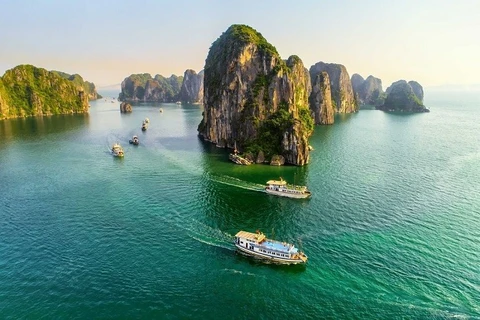Hanoi (VNA) – The Vietnam Administration of Seas and Islands (VASI) under the Ministry of Natural Resources and Environment has focused resources to complete the marine spatial planning based on comments from ministries, departments, industries and 28 coastal provinces and cities nationwide.
The guiding idea of the plan is to ensure harmony between socio-economic development, national defence and security, conservation of nature, ecology, biodiversity, natural wonders and environmental protection while promoting cultural and social values, historical traditions and marine cultural identity.
The national marine spatial planning is an important tool to realise the "National Master Plan" and create a basis for the effective management of exploitation and use of natural resources, environmental protection, conservation of marine ecosystem, while contributing to the formation of strong marine economic sectors, creating more livelihoods for people, ensuring national defence and security, and maintaining national sovereignty, sovereign rights and jurisdiction at sea.
The completion of the planning aims at the goal that by 2050, all Vietnam's sea territory will be effectively managed and used sustainably, meeting the requirements of socio-economic development and national defence and security and realising the goal of turning Vietnam into a powerful marine country.
At the same time, the planning will concretise the main objectives, contents and solutions of the strategy for sustainable development of Vietnam's marine economy to 2030, with a vision to 2045, in line with guidelines and orientations of the Party, relevant national plannings and the strategy on exploitation and sustainable use of natural resources and environmental protection of sea and islands to 2030 with a vision to 2050.
According to VASI, the coastal zone planning is built in accordance with guidelines and orientations of the Party and State on marine economic development and protection of the marine and island environment and ecosystems in combination with safeguarding national sovereignty over seas and islands. Those who engage in the work have also consulted the guidance of the Intergovernmental Oceanographic Commission (IOC/UNESCO), the Partnership for the East Asian Sea (PEMSEA) on planning approaches and methods, as well as international experience in developing and implementing coastal zone planning of the US, UK, Germany, Denmark, Norway, Australia, China and some countries in ASEAN.
According to Vice Chairman of Nghe An Provincial People's Committee Nguyen Van De, the provincial planning for the period of 2021-2030, with a vision to 2050, has integrated goals and tasks associated with the National Marine Spatial Planning and the master plan on exploitation and sustainable use of coastal resources in the period of 2021 - 2030, with a vision to 2045.
Nghe An province is pooling resources to develop a strong marine economy, build up capacity to adapt to climate change and sea level rise; gradually stop and reverse pollution, degradation of the marine environment, coastal erosion and sea erosion; form marine culture and restore and preserve marine ecosystems.
Ha Tinh is one of the first two provinces of the country to get the Prime Minister's approval of their provincial planning for the period of 2021-2030, with a vision to 2050.
Accordingly, by 2030, Ha Tinh province aims for rational exploitation and effective use of sea and island resources for rapid and sustainable development of marine and coastal economic sectors in the priority order of tourism and marine services; maritime economy; marine mineral resources; marine aquaculture and fishing; coastal industry; renewable energy and new marine economic sectors.
For the target to 2050, Ha Tinh sets a target that sea and island resources will be rationally exploited and effectively used on the basis of green growth, preserved marine biodiversity, marine environment and natural resources, green and clean islands, society which are harmonious with the nature.
Ramla Khalidi, UNDP Resident Representative in Vietnam, said that accelerating marine spatial planning is essential to unlocking the great potential of offshore wind power development in Vietnam, contributing to implementing sustainable development goals and climate change response goals./.
























